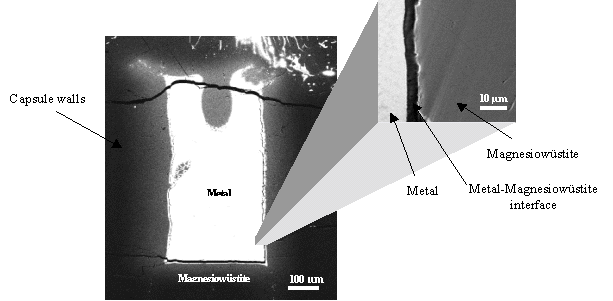

Different theories have been proposed to explain the overabundances of highly siderophile elements (HSE, Dmet/sil. > 104) in the upper mantle: 1) inefficient core formation, 2) equilibrium between metallic liquid and mantle silicates at high pressure during core formation, and 3) heterogeneous accretion involving accretion of a late "chondritic veneer". To choose between such models, knowledge of the solubilities and partitioning of HSE as a function of temperature, pressure, oxygen fugacity (fO2) and melt composition is necessary. In addition, because the Re/Os isotopic system is important for understanding magma processes during the early history of the Earth, the solubility and partitioning behavior of these two elements are of particular interest.
During the last few years, the solubilities of Re and Os in silicate liquids have been investigated at atmospheric pressure and there have been only a few studies of Re partitioning at high pressure. In most cases the high-pressure studies have been performed on liquid metal/silicate melt systems and have involved some experimental difficulties. The quenched silicate liquid is difficult to analyse due to low concentrations of HSE and/or the presence of metal grains. In addition, the silicate melt interacts with the capsule material (generally MgO or Al2O3) leading to a change of the silicate melt composition during the experiment. In the present work, we have studied the partitioning of Re and Os between liquid metal and magnesiowüstite at high pressures and temperatures. The experimental method eliminates the sample contamination problem and provides data on an important lower mantle phase that lies on or close to the peridotite liquidus.
High-pressure experiments were performed between 5 and 10 GPa and temperatures of 1900-2200°C for 30 min using a 1200-tonne multianvil apparatus. A Fe-rich metallic sample (25.7-41.7 wt% Ni, 8.4-15.5 wt% Os and 5.6-8.5 wt% Re), which is liquid at the run conditions, was contained in an MgO capsule. During the experiments, the MgO capsule reacts with the liquid metal to form magnesiowüstite. After completion of the experiment, the compositions of the quenched metal compositions and Fe, Ni, Mg contents of the magnesiowüstite were analyzed using a CAMECA SX50 electron microprobe. Re and Os concentration in the magnesiowüstite were analyzed at the University of Bristol by laser ablation inductive coupled plasma mass spectrometry (LA-ICP-MS). For the latter analyses, the standard consisted of a Re-Os bearing glass prepared in Bayreuth and analyzed for Re and Os contents by isotopic dilution negative thermal ionization mass spectrometry (ID-NTIMS) at IPG, Paris. In preliminary experiments, polycrystalline MgO capsules were used (see 1998 Annual Report). Because of percolation of liquid metal along the grain boundaries in the MgO, together with its small grain size (~30 µm), it was not possible to analyse the magnesiowüstite for Re and Os using LA-ICP-MS without serious contamination from metal (Fig. 3.3-1). This problem has been largely overcome by using capsules fabricated from single crystals of MgO.
SEM imaging of the samples after the experiments reveals areas near the interface with the metal that are free of metal inclusions and thus suitable for LA-ICP-MS analysis (Fig. 3.3-2). Ablations of 40 µm diameter in the magnesiowüstite were performed close to the metal interface but far enough away to avoid contamination of the analysis by metal.
 |
To estimate the effect of pressure and temperature on the partitioning of Re and Os between metal (met) and magnesiowüstite (mw), we considered the exchange partition coefficient that is independent of fO2 and which can be calculated for element M from:
where X represents the molar fractions.
Our results show that the effects of temperature and pressure on the partitioning of Os and Re in the P-T range 5-10 GPa and 1900-2200°C are small (Fig. 3.3-3). A comparison of our high-pressure results with those of previous studies (mainly metal-silicate systems) suggests that the partition coefficient for Re may decrease slightly with both temperature and pressure (Fig. 3.3-3).
 |
|
a)
 |
b)
 |
Partition coefficients determined at high pressure and temperature for Re and Os
are several orders of magnitude lower than those determined at 1 bar and
temperatures of 1350-1400°C ( and
and  )
and also suggest that Re and Os become less siderophile
at high pressures and temperatures. The results for Re show that the KD
value required to explain the current abundance of Re in the mantle by
equilibrium core formation can readily be reached at high pressures and
temperatures. Partition coefficients for Os, on the other hand, are still
three orders of magnitude too high, thus implying the need for a late "chrondritic
veneer" at the end of accretion after formation of the Earth's core.
)
and also suggest that Re and Os become less siderophile
at high pressures and temperatures. The results for Re show that the KD
value required to explain the current abundance of Re in the mantle by
equilibrium core formation can readily be reached at high pressures and
temperatures. Partition coefficients for Os, on the other hand, are still
three orders of magnitude too high, thus implying the need for a late "chrondritic
veneer" at the end of accretion after formation of the Earth's core.

Tel: +49-(0) 921 55 3700 / 3766, Fax: +49-(0) 921 55 3769, E-mail: bayerisches.geoinstitut(at)uni-bayreuth.de
 Previous page
Previous page